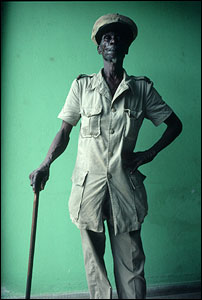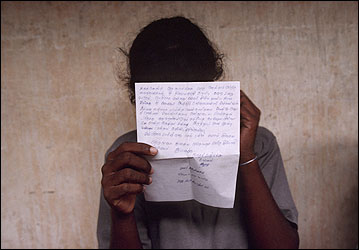 |
Covering the entire range of combatants of the past one hundred years,
across boundaries of culture, geography and time, this project is
meant as a polyphony of voices revealing how people find themselves
in war, what happens to them there, and the marks that remain when
the fighting is over.
If I discovered any single universal truth about war in the years
of this book’s gestation, it is that it is a deeply personal
experience. This is reflected in the many roads that people take to
get there. While generally young and disadvantaged, the men, women
and children who fight on the frontlines hail from all walks of life.
Conscripts and volunteers, patriots and rebels, those lured by adventure,
and those bound by a sense of duty.
What
is common to all is the aftermath. Here, one culture mirrors
another. It makes no difference if one has been in a "bad"
war or a "good" war, justified or unjustified, on
the winning or losing side. As Elvigio Pellitero, who fought
in the Nationalist army under General Franco during the Spanish
Civil War, said: “We were ignorant. We thought we would
probably die, that’s all. We fought, we won. If we had
lost it would have been just the same.”
During a visit to the Vietnam Veterans Memorial Wall in Washington
D.C in 1991, I noticed children looking at the veterans there
with an odd curiosity. Indeed, there was something inherently
different about them. Civilian visitors are perhaps daunted
by the number of names on the Wall and angered or saddened by
what happened in Vietnam. But the veterans visiting the site
are not removed from the experience. They carry war with them
day to day. They’ve been responsible for death, and faced
their own. There is an aura around them, an aura born of having
witnessed something that should never be seen. It was this I
wanted to capture. I wanted to get past the macabre curiosity,
which I too had, and to move through the fear and horror of
seeing them with a missing limb or a burnt face—to see
veterans beyond their wounds, but to capture the war in their
wounds and through their memories. |


WWII vet in Bénin |
1991
© Lori Grinker |
|
The question of which conflicts can truly be called a “war”
came up numerous times during the course of this work. The Vietnam
War was never declared a war, nor was the Korean War or the Algerian
War of Independence. Officially, “the Troubles” in Northern
Ireland are not a "war," and neither is the Palestinian
Intifada. When asked about this, ex-combatants all responded the same
way: “We bleed the same blood, we kill and die with the same
bombs and bullets whether you call it a conflict or an insurrection,
whether it’s been officially declared war or not. What’s
the difference?”
Over the past fifteen years this project was supported through publication
in magazines, several generous grants, and the guidance of my agency,
Contact Press Images. When the time came to turn Afterwar into a book,
Contact’s director, Robert Pledge, who had been involved since
the inception of the project, and I sat down and discussed the layout.
Ultimately it was decided to organize the book in reverse chronological
order, from the most recently ended conflicts, reaching back in history
to the early part of the century. Reverse order is a way to peel back
the layers of time, a way of tracing the mad route of the past century
back towards its origins.


Sri
Lanka Civil War veteran |
1999
© Lori Grinker |
|
While
working in some thirty countries during the course of this work,
in addition to research and planning, I followed to some extent
a more poetic impulse, trusting the accidents of fate that led
me to my subjects. It was never my intention to create an encyclopedia
of war.
Each chapter contains a small section of data, including numbers
of casualties for each conflict in the book. Whenever possible,
I listed both the number of killed and wounded. Where extreme
discrepancies in the figures appeared in a variety of sources,
I’ve included a range of numbers. |
A final issue of historical authenticity inevitably came up in the
matter of names used in this book, of both the wars and their combatants.
Wars often have several names, depending on which country writes the
history. “The Vietnam War” to Americans is “The American
War” to the Vietnamese. To resolve this dilemma, in the book’s
timeline, wars are listed by the most commonly used name in addition
to the name used by the participants themselves. If adults gave permission
to use their full names, they have been included as such. In order
to protect the children included in these pages only their first names
have been used.
The past century was one of history's deadliest. More than one hundred
million people died in over one hundred and fifty conflicts. Countless
others were wounded as nationalism, competing ideologies and religions,
and genocidal conflicts raged across Europe, through Asia, Africa
and the Americas. There is no reason to believe it will end anytime
soon. Those sent to war are cannon fodder, and we live vicariously
through their violent experience. We watch the reports from the front
on television as if it were a spectator sport. But they suffer for
us. They are our sacrificial lambs. I hope their images and words
will serve as a powerful reminder of the wastefulness of war.
|
Lori
Grinker
New York City, April 2004
From Afterwar: Veterans From a World in Conflict by
Lori Grinker
(de.MO 2004) |
 |
|




